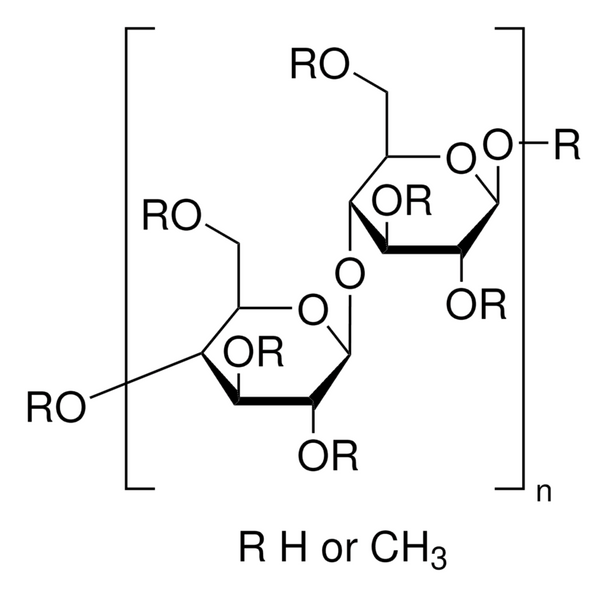Description
Methyl cellulose
viscosity: 15 cP, BioReagent, suitable for cell culture
CAS Number:
9004-67-5
MDL number:
MFCD00081763
PubChem Substance ID:
24897135
NACRES:
NA.75
PROPERTIES
biological source
synthetic (organic)
product line
BioReagent
form
powder
technique(s)
cell culture | mammalian: suitable
viscosity
12-18 cP, 2 % in H2O(20 °C)
solubility
water: 50 mg/mL, clear to hazy
SMILES string
[*]OC[C@H]1O[C@@H](O[C@@H]2[C@@H](CO[*])O[C@@H](O[*])[C@H](O[*])[C@H]2O[*])[C@H](O[*])[C@@H](O[*])[C@@H]1O[*]
InChI key
YLGXILFCIXHCMC-JHGZEJCSSA-N
General description
Methyl cellulose is obtained by etherification of cellulose. This commercial cellulose ether exhibits amphiphilic properties and original physicochemical properties. Methyl cellulose is enzyme resistant, non-digestible, non-allergic, and non-toxic.
Application
Methyl cellulose has been used:
- as a vehicle for metformin drug during oral gavage
- as a component of mammary epithelial cell growth medium for mammosphere culture
- as a supplement in spheroid 3D co-cultures for spheroid invasion assays using hanging drop protocol
Methyl cellulose is used to create semi-solid matrices,[1][2] as a cell culture gel, for culture of colony forming cells[3][4] such as CFU-G; CFU-GM; cells and other cells used in toxicity assays. Low viscosity, not for plaquing assays or cloning.
Biochem/physiol Actions
Methyl cellulose finds applications in various industries such as in the food industry it is used as an emulsifier, texturing agent, thickener, and gelling additive. Methyl cellulose is also used in various cosmetics and personal care products such as hair shampoos, hair styling products, liquid soaps, body washes, lotions and creams, and toothpaste to yield their characteristic thick consistency. In addition, it serves as an additive for pharmaceuticals and is used in the production of capsules for nutritional supplements. Methyl cellulose is used as an alternative to glycerol in a cryopreservation medium. It is used along with culture supplements to enhance proliferation and differentiation in multiple or single lineage-committed hematopoietic progenitor cells. This cellulose derivative also has the potential to prevent the loss of adhesive properties and cell functions of various cell types including human skin fibroblasts, human melanoma cells, and mouse lung fibroblasts cultured in suspension.
SAFETY INFORMATION
Storage Class Code
11 - Combustible Solids
WGK
WGK 1
Flash Point(F)
Not applicable
Flash Point(C)
Not applicable
Personal Protective Equipment
dust mask type N95 (US), Eyeshields, Gloves





